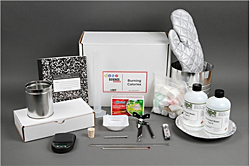Burning Calories: Putting Nutritional Value to the Test
Do you use a package's nutritional information when making food choices? Can you trust the accuracy of the information? Nutritional content requirements are becoming more widespread, but the information on a label or a restaurant brochure may or may not be correct. Students can learn more about nutrition and explore the kinds of science involved in analyzing a food's nutritional composition by holding favorite foods to the fire, literally! Which foods offer the most chemical energy for the body?
A short documentary film titled "Calorie Detective" recently debuted on the New York Times "Opinion" page. The film, which runs just over five minutes, combines a catchy sound score, DIY-inspired presentation of data, and nitty-gritty science. The result is an engaging video that lets viewers tag along as the filmmaker takes an informal look at the nutritional content information provided for both packaged and made-to-order foods.
Food package labeling is regulated by the Food and Drug Administration, and new policies may require the availability of nutritional information at chain restaurants. While restaurants and food manufacturers are required to make caloric and nutritional data available, the information is not necessarily checked, validated, or monitored. Does the cinnamon raisin bagel you had for breakfast really have 210 Calories?
Student Science
Students interested in food science and kitchen chemistry can get hands-on with the Burning Calories: How Much Energy is Stored in Different Types of Food? analysis of the chemical energy offered by various foods. A science kit is available.
Student food scientists can also investigate a food's supplemental iron content using the Mag-nificent Breakfast Cereal biotechnology Project Idea.
In an increasingly health-conscious age, many people make food purchase choices based on the perceived health content of the product or food, which often boils down to the number of Calories or the amount of fat noted on the label. For many health-conscious diners, a discrepancy between the information on the label and the actual nutritional value may be trivial, an inconvenience, or a matter of brand honesty. For other diners, the accuracy of nutritional data is more serious. For example, for someone using nutritional data for medical reasons (like calculating carbohydrates in order to determine insulin needs), the legitimacy of the information provided by a label or restaurant nutritional data can be critically important and a misrepresentation of nutritional data may have immediate and potentially serious health consequences.
In the "Calorie Detective" video, filmmaker Casey Neistat puts an assortment of his favorite daily food purchases, including a breakfast muffin, a Starbucks Frappuccino, and a packaged tofu sandwich from the grocery, to a "nutritional content accuracy" test. With the help of scientists at the New York Obesity Nutrition Research Center, Casey compared the stated caloric content of five foods with the actual Calories contained in each. According to the video, the food testing to determine the actual number of Calories in each food took ten hours, precision lab equipment, the help of two food scientists, and a lot of math.
While the tests for "Calorie Detective" were conducted by scientists, the testing for the film is largely informal. They didn't run multiple trials for each of the foods, a step that would give a look at the average number of Calories for each food to compare to the stated nutritional value data. The results are not statistically conclusive. However, as the "Calorie Detective" film shows, what you see on the billboard when you order, on a package label at the store, or on a glossy nutritional card by the cash register, may or may not tell the whole story. Things get particularly tricky when items are made by hand, as you order. Maybe you end up with a double scoop, a bigger handful, or an extra squirt. There goes the accuracy of the average nutritional content data for the item!
Making Connections
Students curious about how scientists, like the ones shown in the video, test and determine nutritional information can take hands-on steps in food science with an exploration of another aspect of nutritional value—how much energy a food offers the body. When your body breaks down and digests a food, not all Calories offer the same value to the body. You may guess that the potential "energy" stored in food has something to do with the amount of protein, fat, and carbohydrates in the food. But what is the relationship? What kinds of foods offer the most chemical energy or the best bang for the number of Calories?
In the Burning Calories: How Much Energy is Stored in Different Types of Food? food science Project Idea, students can conduct their own food testing and get answers by setting food on fire, using a homemade calorimeter, and simulating the oxidation of food to measure the energy that cells can use or store from different foods.
Categories:
You Might Also Enjoy These Related Posts:
- 10+ Robotics Projects with the BlueBot Kit
- 15 STEM Gifts & Science Kits You'll Feel Good About Giving
- 12 Science Kits for Summer Science Experiments and Discovery
- Build a Water Sensor Circuit for the Tree
- Science Project Kits - Our top 10 list!
- Explore Coding and Electronics with Raspberry Pi
- Three new Science Kits for K-12 STEM
- Shoebox STEM: A 4-H Success Story










